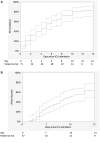Characterization of acute kidney injury in critically ill patients with severe coronavirus disease 2019
- PMID: 32695326
- PMCID: PMC7314187
- DOI: 10.1093/ckj/sfaa099
Characterization of acute kidney injury in critically ill patients with severe coronavirus disease 2019
Abstract
Background: Coronavirus disease 2019 (COVID-19)-associated acute kidney injury (AKI) frequency, severity and characterization in critically ill patients has not been reported.
Methods: Single-centre cohort performed from 3 March 2020 to 14 April 2020 in four intensive care units in Bordeaux University Hospital, France. All patients with COVID-19 and pulmonary severity criteria were included. AKI was defined using Kidney Disease: Improving Global Outcomes (KDIGO) criteria. A systematic urinary analysis was performed. The incidence, severity, clinical presentation, biological characterization (transient versus persistent AKI; proteinuria, haematuria and glycosuria) and short-term outcomes were evaluated.
Results: Seventy-one patients were included, with basal serum creatinine (SCr) of 69 ± 21 µmol/L. At admission, AKI was present in 8/71 (11%) patients. Median [interquartile range (IQR)] follow-up was 17 (12-23) days. AKI developed in a total of 57/71 (80%) patients, with 35% Stage 1, 35% Stage 2 and 30% Stage 3 AKI; 10/57 (18%) required renal replacement therapy (RRT). Transient AKI was present in only 4/55 (7%) patients and persistent AKI was observed in 51/55 (93%). Patients with persistent AKI developed a median (IQR) urine protein/creatinine of 82 (54-140) (mg/mmol) with an albuminuria/proteinuria ratio of 0.23 ± 20, indicating predominant tubulointerstitial injury. Only two (4%) patients had glycosuria. At Day 7 after onset of AKI, six (11%) patients remained dependent on RRT, nine (16%) had SCr >200 µmol/L and four (7%) had died. Day 7 and Day 14 renal recovery occurred in 28% and 52%, respectively.
Conclusion: Severe COVID-19-associated AKI is frequent, persistent, severe and characterized by an almost exclusive tubulointerstitial injury without glycosuria.
Keywords: COVID-19; acute interstitial nephritis; acute kidney injury; acute tubular injury; critically ill patients; renal replacement therapy.
© The Author(s) 2020. Published by Oxford University Press on behalf of ERA-EDTA.
Figures
References
-
- Grasselli G, Pesenti A, Cecconi M.. Critical care utilization for the COVID-19 outbreak in Lombardy, Italy: early experience and forecast during an emergency response. JAMA 2020; 323: 1545 - PubMed
LinkOut - more resources
Full Text Sources
Miscellaneous



